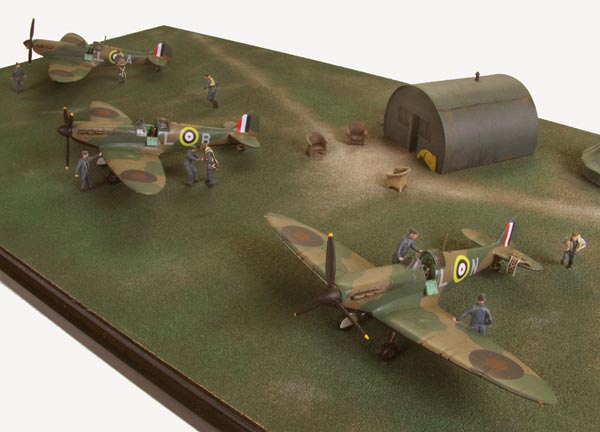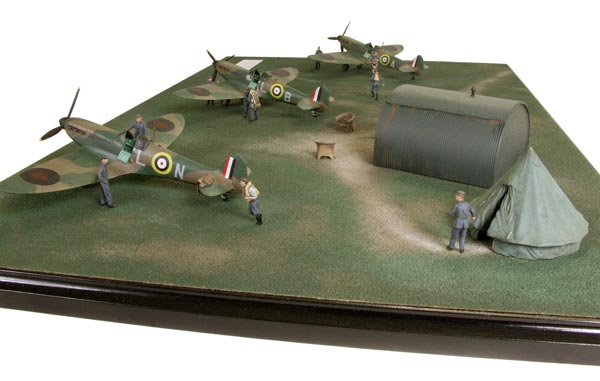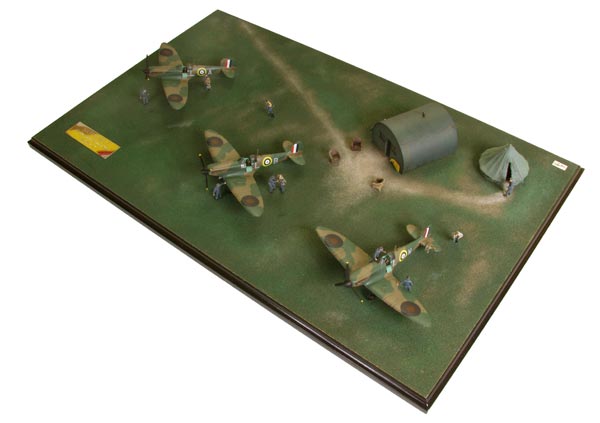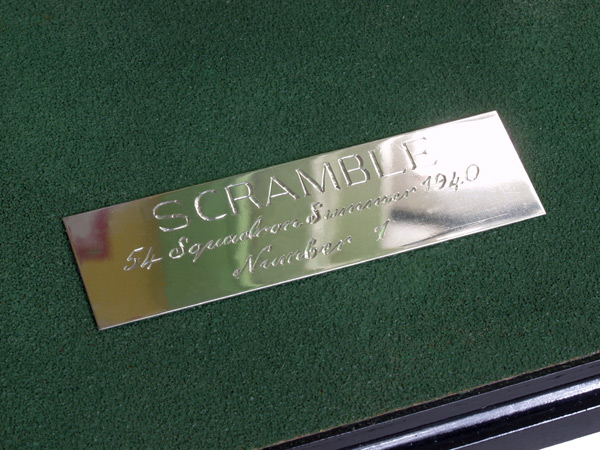‘Scramble’
Supermarine Spitfire Mk I KL-A P9389, KL-B N3183, KL-N N3173,
54 Squadron, Hornchurch, May 1940.
Supermarine Spitfire Mk I P9389 / KL-A of Sqn Ldr James Leathart, OC
‘Prof’ Leathart was flying this aircraft on 21 May when he engaged a He 111 near Dunkirk during one of the first engagements by Spitfires over northern France, he was awarded an unconfirmed kill for the Heinkel. Leathart led No 54 Sqn throughout the summer of 1940, and eventually finished the war with a tally of 7 and 1 shared destroyed, 3 and 1 shared unconfirmed, 2 probables and 3 damaged – all bar one of his kills was scored flying Spitfire Mk Is. P9389 was shot down by a Bf 109 during the afternoon of 24 August.
Supermarine Spitfire Mk I N3183 / KL-B KIWI of Plt Off Alan Deere
Deere used this aircraft to shoot down a Bf 1 09E (24 May) and a Bf 110 (25 May) during actions in suppont of the Dunkirk evacuation, where he was credited with seven victories (plus 1 shared, 1 unconfirmed and 1 damaged) in just five days. The aircraft was shot down by elements of 11./JG 51 in a bitter action over the Channel on 9 July 1940, its pilot, Plt Off A Evershed, being killed – No 54 Sqn lost two other Spitfires in this action, with a second pilot being killed and Al Deere being slightly burnt when he had to force land P9398 near Manston.
Supermarine Spitfire Mk I N3173 / KL-N of Plt Off Colin Gray
On the 25th of May the first Allied troops were evacuated from the port of Dunkirk. Also on that day No 54 Sqn escorted a squadron of FLeet Air Arm Swordfish delivering an attack on German troops between Gravelines and Calais. The biplanes completed their attack without interference, and headed for home. Once they were safely on their way the Spitfires were free to head south looking for trouble. They soon found it, as Plt Off Colin Gray later recalled;
‘Suddenly, we found ourselves in amongst a gaggle of 109s. I but it opened fire at one of them, but stopped when I noticed smoke coming back over my wings. That shook me – I thought somebody was firing at me. I pulled round hard but there was nobody there what I had seen was cordite smoke blowing back from my own guns. I looked back at the Messerschmitt and saw Sgt John Norwell (who would later become an ace,) on its tail and the German pilot baling out.’
Norwell and Gray would each be credited with half shares in the destruction of the Messerschmitt. As the German fighter went down, Gray spent too long watching his victim – an error that nearly cost him his life.’ ‘Suddenly, there was one Hell of a row, like somebody running a bar along a piece of corrugated iron. The stick was knocked out of my hand and ended up in the left hand corner of the cockpit, and my aircraft flicked into a spiral dive. I grabbed the stick and hauled back on it, and the Spitfire responded immediately and started to climb. I looked behind but didn’t t see anyone – the German pilot had not repeated my mistake of following me down. I selected +12 lbs (emergency boost) and continued my climb – the airspeed indicator read 240 mph, and I thought “This is bloody marvellous!” (the normal speed for a Spitfire in a steep climb was about 190 mph indicated). But then, as I continued the climb, the Spitfire began to shudder and it seemed as if it was going to stall. I couldn’t understand it – the air speed indicated still read 240 mph. I eased the stick forwards, but still it read 240 mph . . .Then I realised what had happened – my pitot head had been shot away, and the needle had dropped to the 240 mph position on the dial under gravity.’ .’I levelled out and took stock of the situation. One cannon shell had I gone through the port aileron, and that was what had knocked the stick out of my hand and sent the aircraft into the violent spiral dive which shook off the Messerschmitt. The airspeed indicator was out, and there was no air pressure or hydraulic pressure. That meant that I had no flaps or brakes and I couldn’t lower the undercarriage using the main hydraulic system. As I approached Hornchurch I blew down the undercarriage using the emergency carbon dioxide system, and saw the “undercarriage down” sticks push up through the wings and two green lights come on to indicate that the wheels were down and locked.’ ‘The landing was very difficult. With the flaps up one came in at a different attitude than usual and, of course, I had no idea of my air speed – the indicator still read 240 mph! The first time, I came in too fast. The station commander at Hornchurch, Wg Cdr “Daddy” Bouchier, was watching my performance and was overheard to say “The silly young bugger.
He’s going too fast. He’ll never get in!” He was right. I got my wheels almost on the ground, realised I was not going to make it and took off again. The second time I stood well back from the airfield, and dragged the aircraft in at just above stalling speed. That time I landed and as I touched down the elevator cable finally parted and the control column collapsed back into my stomach.’
‘On examination of the Spitfire afterwards it was found that a cannon shell had gone through the inspection hatch in the rear fuselage and exploded inside. Splinters from the shell had slashed their way out of the skinning, leaving it looking like a cheese grater. The air bottles had been knocked out, so were the batteries. There were bullet holes up and down the fuselage and, of course, the cannon shell through the aileron. From the entry and exit holes of the bullets it was clear the Messerschmitt had dived on me from the right and above – it had been a very neat piece of deflection shooting.’ The Spitfire (N3173) was put up on trestles and people from Vickers were invited to come and look at it to see how much it had suffered. It was the first Hornchurch aircraft that had been fairly well clobbered and still got back. Soon there would be many others.’
Colin Gary would become one of the most successful Spitfire pilots, and also the top-scoring New Zealander of the war. Yet of his many actions, his most memorable was the one when lack of experience so nearly brought a premature end to his flying career.
Source : Osprey Aviation Books, Aircraft of the Aces Vol 12. ISBN 1-85532-627-2
Scale 1:72 Base size 23.5″ x 14.5″ (600mm x 370mm)
Limited Edition of 50 only
SOLD OUT





